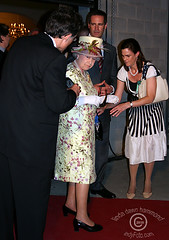Native protesters try to greet the Queen at St.James
Queen's visit © Linda Dawn Hammond / IndyFoto.com 2010
Native rights protesters moved to other side of street, then questioned by police, and a man asked to drink the fluid in a water bottle he was carrying to prove it wasn't caustic. Since the G20 summit a week ago, the Toronto police have been acting aggressively, exercising rights to question and detain citizens based on superficial evaluations. It now appears the special powers accorded to the police to interrogate and arrest near the perimeter fence have been revealed as an intentional misconception.
READ
‘No extra powers’ granted to police during G20 summit: Liberals"
www.thestar.com/news/gta/torontog20summit/article/830030-...
The protest did seem a little misguided as the complaints could have more accurately been levelled towards the Catholic church rather than at a Protestant one- and the Queen can hardly be held personally responsible for all grievances that occur. Nevertheless, this dates back to a historic precedent and responsibility towards the First nations people.
www.winnipegfreepress.com/opinion/westview/special-royal-...
"After the British gained military control over lands in North America formerly under French control, King George III's priority was to ensure peace and friendship with First Nations. He issued the Royal Proclamation of 1763, which is still part of the Canadian Constitution, to recognize that First Nations had control over their lands and to establish a process for ceding lands to the British Crown to facilitate European settlement. The Supreme Court of Canada has stated that the treaty process "serves to reconcile pre-existing aboriginal sovereignty with assumed Crown sovereignty."
Subsequently, about 500 nation-to-nation treaties were signed between the First Nations in Canada and the Crown. The Royal Commission on Aboriginal Peoples (1996) noted that "because of this relationship, the Crown acts as the protector of the sovereignty of aboriginal peoples within Canada and as guarantor of their aboriginal and treaty rights. This fiduciary relationship is a fundamental feature of the constitution of Canada."
Chief R. Donald Maracle of the Mohawks of the Bay of Quinte, was one of two Mohawk leaders representing two Royal Chapels located on First Nations territories in Ontario. They were invited to meet the Queen and Prince Philip at St. James Cathedral, where the Queen presented a gift of eight silver hand bells engraved "The Silver Chain of Friendship 1710-2010," to mark the 300th anniversary of the 1710 visit of the "four Iroquois kings" with Queen Anne in England. The bells presented to the Tyendinaga Mohawks will be housed at Christ Church, Her Majesty's Chapel Royal of the Mohawks near Deseronto, Ontario was designated a national historical site in 1995.
www.tyendinaga.net/history/
Tyendinaga Mohawks, "Kanyen'kehaka, the people of the flint"







